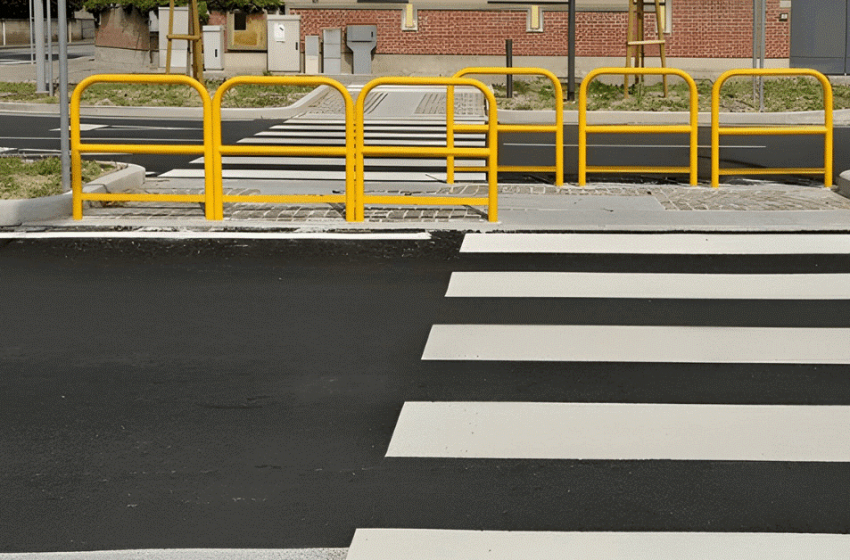The Role of Pedestrian Barriers in Ensuring Public Safety

In urban environments, public safety is a primary concern, especially as cities become more crowded and bustling with activity. As pedestrian traffic increases, there is a growing need for solutions that protect individuals from potential hazards, ranging from traffic accidents to unsafe walkways. One of the most effective methods used to safeguard people in these environments is the installation of pedestrian barriers. These structures play a vital role in maintaining order, guiding movement, and preventing accidents in various public spaces.
Why Are Pedestrian Barriers Important?
Pedestrian barriers serve multiple purposes. Primarily, they are used to manage the flow of foot traffic in busy areas such as streets, festivals, and public events. However, their significance goes beyond simply guiding people from one point to another. They also function as protective barriers that shield individuals from high-risk areas like busy roads, construction sites, and hazardous work zones.
Without adequate barriers, pedestrians are at higher risk of stepping into danger, whether that’s accidentally walking into the street, encountering uneven ground, or being too close to a high-traffic area. Pedestrian barriers provide an organized system that not only improves movement but also creates safe zones where people can walk freely without concern.
Types of Pedestrian Barriers
There are various types of barriers, each designed to serve a specific purpose in different settings. Let’s explore a few common types:
- Temporary Barriers: Temporary pedestrian barriers are most often used during large public events, parades, or festivals. They are lightweight, mobile, and easy to install or remove, making them ideal for short-term use. These barriers are critical for ensuring crowd control and guiding foot traffic through designated areas.
- Fixed Barriers: Fixed pedestrian barriers are more permanent solutions typically used in urban planning to separate pedestrians from vehicular traffic. You will often see these in busy city centers, sidewalks, or in areas with high vehicle activity like intersections or busy streets. These barriers are sturdy and designed to last for long periods.
- Construction Barriers: Construction sites present several risks to the public. Barriers in such areas are crucial in keeping pedestrians out of dangerous zones where heavy machinery, debris, and hazardous materials may be present. By clearly marking off these areas, construction barriers protect both workers and the general public.
- Railings and Guardrails: Found near high ledges, steep drop-offs, or along bridges, these barriers are designed to prevent falls and ensure pedestrians remain within safe zones. In places like train stations or airports, railings also serve to organize the movement of large groups of people, ensuring safety during high-traffic times.
- Retractable Barriers: Retractable pedestrian barriers are increasingly popular due to their flexibility and space-saving design. These barriers can be extended and retracted as needed, making them ideal for temporary use in places like airports, museums, or event venues.
Ensuring Public Safety with Pedestrian Barriers
- Traffic Control and Accident Prevention: One of the most critical functions of pedestrian barriers is traffic control. In busy urban areas, these barriers serve as a physical boundary between pedestrians and fast-moving traffic. This is especially important at intersections and crosswalks, where the risk of accidents is higher. By guiding pedestrians to stay within designated paths, barriers prevent jaywalking and other unsafe crossing behaviors.
In addition, barriers for pedestrians reduce the likelihood of accidents in areas where vehicles and pedestrians share close proximity, such as shopping centers or parking lots. These structures are essential for minimizing risk and ensuring smooth pedestrian flow, even in high-traffic areas.
- Crowd Management at Events: During public gatherings or large-scale events, managing crowds becomes a significant challenge. Pedestrian barriers play a key role in controlling large groups, directing people safely, and preventing overcrowding in confined spaces.
These barriers help create organized entry and exit points, making it easier for event organizers and security personnel to manage large numbers of attendees. In the event of an emergency, clear barrier placements can also guide people toward safe evacuation routes, potentially saving lives.
- Construction Site Safety: Construction zones pose unique hazards, both for workers and the public. Pedestrian barriers placed around construction sites keep the public at a safe distance from heavy machinery, open excavations, and falling debris. With clear signage and barriers, the risks associated with walking near these areas are significantly reduced.
For construction companies, using barriers demonstrates a commitment to public safety, ensuring they comply with regulations that require protective measures for pedestrians. This not only helps prevent accidents but also fosters a sense of security among residents and passersby.
- School Zones and Play Areas: Children are among the most vulnerable pedestrians, especially around schools, parks, and playgrounds. Pedestrian barriers in these areas are essential for creating a buffer between children and roads, keeping them within safe boundaries as they walk, play, or wait for their rides.
In school zones, barriers also serve to guide traffic flow during drop-off and pick-up times, ensuring that children and their parents are not at risk of vehicular accidents. This is particularly important in areas where traffic congestion is high during certain times of the day.
- Improving Accessibility: In addition to safety, pedestrian barriers also improve accessibility for all members of the public, including those with disabilities. Barriers can be designed to include features like ramps, guiding rails, and other elements that enhance movement for individuals with mobility challenges.
By ensuring that public spaces are both safe and accessible, pedestrian barriers contribute to creating inclusive environments where everyone, regardless of physical ability, can move freely and safely.
Conclusion
Pedestrian barriers play a fundamental role in ensuring public safety in a wide variety of settings. From preventing accidents in busy urban streets to guiding large crowds during events, these structures are an essential part of urban infrastructure. They not only protect people from harm but also help manage movement, reduce congestion, and create orderly, secure environments.
As urban spaces continue to evolve and populations grow, the importance of effective pedestrian safety measures cannot be overstated. Pedestrian barriers are a simple yet highly effective solution to the many challenges posed by increased foot traffic, construction, and public events. By integrating these barriers into public spaces, cities can ensure that pedestrians are safeguarded, providing them with the freedom to move about confidently and securely.
In today’s fast-paced world, where safety is a top priority, the use of barriers for pedestrians is more important than ever. Whether in everyday urban settings or large-scale public gatherings, the proper implementation of pedestrian barriers helps create a safer, more organized environment for everyone.

